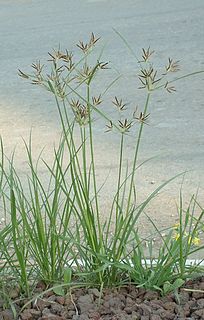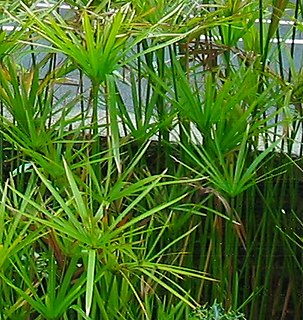
Cyperus papyrus, better known by the common names papyrus, papyrus sedge, paper reed, Indian matting plant, or Nile grass, is a species of aquatic flowering plant belonging to the sedge family Cyperaceae. It is a tender herbaceous perennial, native to Africa, and forms tall stands of reed-like swamp vegetation in shallow water.

The Cyperaceae are a family of graminoid (grass-like), monocotyledonous flowering plants known as sedges. The family is large, with some 5,500 known species described in about 90 genera, the largest being the "true sedges" genus Carex with over 2,000 species.

Parvicursor is a genus of tiny maniraptoran dinosaur with long slender legs for fast running. At only about 39 centimetres from snout to end of tail, and 162 grams in weight, it was initially seen as one of the smallest non-avian dinosaurs known from an adult specimen. However, in 2022 its holotype was concluded to represent a juvenile individual.

Cyperus is a large genus of about 700 species of sedges, distributed throughout all continents in both tropical and temperate regions.

Alioramus is a genus of tyrannosaurid theropod dinosaurs from the Late Cretaceous period of Asia. It currently contains two species. The type species, A. remotus is known from a partial skull and three foot bones recovered from the Mongolian Nemegt Formation, which was deposited in a humid floodplain about 70 million years ago. These remains were named and described by Soviet paleontologist Sergei Kurzanov in 1976. A second species, A. altai, known from a much more complete skeleton, was named and described by Stephen L. Brusatte and colleagues in 2009. Its relationships to other tyrannosaurid genera are unclear, with some evidence supporting a hypothesis that Alioramus is closely related to the contemporary species Tarbosaurus bataar.

Cyperus rotundus is a species of sedge (Cyperaceae) native to Africa, southern and central Europe, and southern Asia. The word cyperus derives from the Greek κύπερος, kyperos, and rotundus is from Latin, meaning "round". The earliest attested form of the word cyperus is the Mycenaean Greek 𐀓𐀞𐀫, ku-pa-ro, written in Linear B syllabic script.

Cyperus alternifolius, the umbrella papyrus, umbrella sedge or umbrella palm, is a grass-like plant in the very large genus Cyperus of the sedge family Cyperaceae. The plant is native to West Africa, Madagascar and the Arabian Peninsula, but widely distributed throughout the world. It has gained the Royal Horticultural Society's Award of Garden Merit. The subspecies Cyperus alternifolius ssp. flabelliformis is also known as Cyperus involucratusRottb..
Euconocephalus remotus is a species of insect in the family Tettigoniidae. It was described by Francis Walker in 1869 and is endemic to the Hawaiian Islands.

Cyperus eragrostis is a species of sedge known by several common names, including tall flatsedge, nutgrass, tall nutgrass, umbrella sedge, chufa, Earth almond, zula nuts, edible galingale and pale galingale.

Cyperus fuscus is a species of sedge known by the common name brown galingale, or brown flatsedge. This plant is native to much of Europe, Asia and North Africa from England, Portugal and Morocco east to China and Thailand. It is an introduced species in North America, where it is naturalized in widely scattered locations in the United States and Canada.

Cyperus scariosus is a perennial herbaceous plant from Australia and New Guinea.

Cyperus laevigatus is a species of sedge known by the common name smooth flatsedge.

Zygoballus remotus is a species of jumping spider which occurs in Guatemala. It was first described by the arachnologists George and Elizabeth Peckham in 1896.
Mascaraneus is a monotypic genus of African tarantulas containing the single species, Mascaraneus remotus. It was first described by R. C. Gallon in 2005, and is endemic to Mauritius.
Copris remotus is a species of dung beetle in the family Scarabaeidae.
Rhizophagus remotus is a species of root-eating beetle in the family Monotomidae. It is found in North America.
Auriglobus remotus is a species of pufferfish in the family Tetraodontidae. It is a tropical freshwater species known only from Indonesia that reaches 6.2 cm SL. Like the other four members of Auriglobus, it was previously classified in the genus Chonerhinos.
Cyperus refractus is a species of sedge that is native to south eastern parts of North America.











